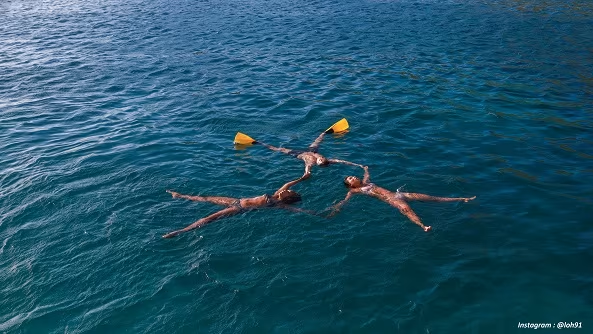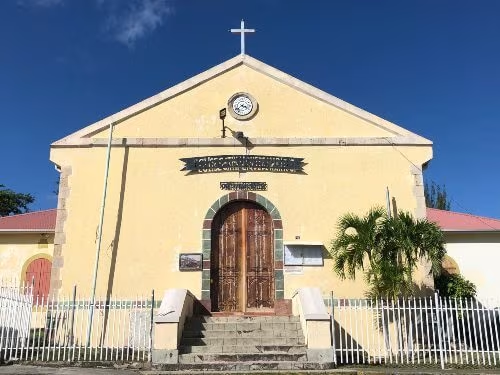Top 5 free activities in Saint Martin and Sint Maarten
1- Visit the typical market of Marigot
Marigot's market is a shimmering mixture of colors, flavors, and scents, in a most sympathetic atmosphere, reflecting the kindness of the Saint-Martinois people. On this picturesque meeting place for the inhabitants of the region, the visitor's five senses are heightened for his greatest pleasure. The most diverse products are housed under Creole huts that are set up along the shore. The choice is rich among the multitude of fruits and vegetables with very exotic names, the stands as colorful as they are fragrant with Caribbean spices, without forgetting the many seafood products caught during the day.
On the market of Marigot, the craft industry is also very present. More than a hundred stalls offer for sale local or global handicrafts. The stalls are all grouped in an arena in the middle of which stands a pretty kiosk. It is an opportunity to admire original works, the fruit of the wandering imagination of gifted artists.
It is in this same place that many specimens of rums arranged in a Saint Martin sauce are exhibited. These are different liqueurs, based on rum mixed with fruits, spices, or Schrub, which are orange peels long macerated in rum. The local infusion is also sold on the Marigot market. It is the Moby which is a decoction made from a bark found on the island.
Two works of art recall the sad part of the Marigot market, which once served as a market for slaves, especially women of color, to whom they pay homage. These are a mural and a stone statue of Martin Lynn.
2- Tour the Sint Maarten National Nature Reserve
On more than three thousand hectares, extends to the North-East of Saint-Martin, a magnificent nature reserve. It is made up of a maritime part and a land part. In the first one, the flora is rich in preserved coral reefs, mangroves, sea phanerogams herbariums, and much more. The fauna is also very diversified, sheltering several protected species. It is possible to explore it by diving in the open sea, by taking part in an underwater snorkeling excursion or onboard a boat, in a canoe or on a pirogue. In the terrestrial nature reserve, you can encounter wild goats on Tintamarre Islet, as well as snowy egrets, ox herons, and water hens. Four discovery trails are laid out to offer visitors to the reserve the opportunity to get to know the dry forest, coastal vegetation, mangrove swamps, and the seabed.
3- Snorkeling in Mullet Bay
Mullet Bay is as heavenly a place as one imagines it to be. It is possible to park your rental car on the dedicated and free parking lot, to enjoy a wonderful day. A warm and translucent sea, a fine white sandy beach and shady palm trees are the backdrop to an exceptional dive site. The two ends of the bay are the most suitable for divers looking for multicolored underwater fauna and flora. Equip yourself with your fins, mask, and snorkel for an underwater hike close to the rocks.

© Credit source : Instagram > @loh91
4- Find the unmissable monuments of Marigot
Many are the monuments to be discovered in Marigot, which contribute to the charm of the city. Take the time to discover them during your walks in the capital of Saint-Martin.
The Republique road is one of the main streets of Marigot. It is lined with facades with traditional 19th-century architecture that are wonderfully preserved. They are composed of two floors of different design: the ground floor is built with stones assembled by lime mortar, while the upper floor is made of wood. An elegant gallery is located on the first floor, facing the street. Decorated with friezes, it is fitted with beautifully worked balustrades.
The Catholic church of Marigot. This church, which is located on the road to Fort Louis, dates from 1941. The reason for this relatively recent construction is that the island of Saint-Martin used to be mainly populated by Anglo-Saxons of the Protestant religion. Made of stone and lime, the church of Marigot was built around the same time as that of Grand-Case, thus anchoring the French Catholic presence on the island.

© Credit source : encirclephotos.com
The old prison in Marigot. Still in the direction of Fort Louis, in a small alley in rue Perrinon, stands the former prison of Marigot. Built-in 1789 on the orders of the governor of the island of Saint-Martin and Saint-Barthélemy, the jails sheltered prisoners until 1968. Since then, prisoners have been incarcerated in the Basse-Terre prison in Guadeloupe. Transformed into a fire station, the facade of the prison has changed little from its origin.
The tomb of François Auguste Perrinon. This Martinican is glorified in Saint-Martin because he was an ardent defender of the abolition of slavery. In particular, he published a work in 1847 which aimed to demonstrate that freed slaves who were fairly paid for their work were far more productive than mistreated slaves. He died in 1861 and is buried in the Marigot cemetery.
5- The Border Obelisk
Erected in 1948, the border obelisk marks the 300th anniversary of the separation of the island between the French and Dutch parts. This monument indicates the symbolic border between the two countries: Saint-Martin in the North, and Sint Maarten in the South. The legend says that the boundary was decided following a race by an athlete from each nation. As the French runner was probably faster, 2/3 of the island came back to France.
Full of assets, the French part of the island is full of charm. From the cosmopolitan capital with trendy shops and tasty restaurants to the very elegant village of Orient Bay, through the picturesque village of Colombier and the friendly fishing port of Grand-Case, the visitor has plenty to fill his days away from the beaches.

Subscribe to our newsletter and receive our best offers of the moment exclusively
CAR RENTAL CATEGORIES
CAR RENTAL LOCATIONS
BEST OF ST MAARTEN


Trip advisor

World Award

Kayak Award
©Europcar St Maarten : Car Rentals
